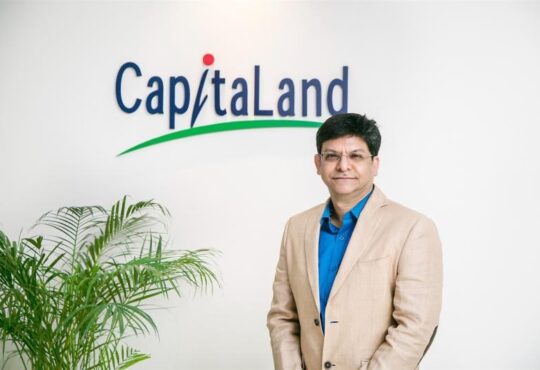Navigating the Future of BFSI: Insights from Vymo on Market Positioning, AI Impact, Gamification, and Talent Retention

CXOToday has engaged in an exclusive interview with Rajesh Sabhlok, Managing Director – Asia Pacific, Vymo.
Could you elaborate on your company’s unique positioning in the market, particularly in terms of the extremely high user adoption metrics and user base? What factors do you attribute to this success?
Vymo is among the fastest growing SaaS companies in the market today. Our unique positioning stems from our strategic focus on the financial sector. This ‘narrow’ focus in defining our Ideal Client Profile has helped us go ‘deeper’ in our understanding of the specific and nuanced challenges faced by sales teams in the financial sector, and ensure the core product covers most of these out of the box, which, in addition to driving user adoption also helps in launching the solution in a much shorter time frame than other solutions which may be ‘broad’ in terms of their industry coverage and therefore ‘shallow’ in their core product alignment to BFSI clients.
While typical enterprise applications see adoption rates of 20%, Vymo’s adoption rate is 75% plus, which can only happen if there is a pull factor – if users can extract personal gains from using the tool, they will use it more often. I believe some of the ways in which we are delivering value to the users are:
- Ease of use – Simple and intuitive UX/UI, specifically designed for the mobile interface
- Convenience – The platform provides the user with a seamless, single-pane-of-glass interface to accomplish their day-to-day work, without having to toggle between 8-10 applications they need to use in a day.
- Efficiency – Automating processes, access to time-tested playbooks, auto-detection of activity data and real-time sync with CRM, MIS systems – thereby freeing up time for users, which can be put to more productive use.
- Effectiveness – The AI and ML capabilities of Vymo are designed to learn winning behaviours from the best sales reps and recommend next best actions to others so as to make them better and professionally astute over time.
- Visibility – Managers and sales leaders are empowered with greater visibility of bespoke developmental needs of their sales teams so that their interventions can be razor-focused and maximise outcomes.
Such capabilities encourage adoption among users and it is easier for users to reap the benefits that the app has been designed to deliver.
In the realm of banking and insurance, how does AI play a pivotal role in helping these industries better understand their customers and enhance their sales strategies? Are there any specific examples you could share?
In today’s day and age where use of digital technology has permeated all aspects of our existence from ordering groceries, hailing cabs, undertaking banking transactions, investments, monitoring health etc. AI and ML models are being used extensively to get a much deeper understanding of their customers, their buying behaviours, likes and dislikes, their health/risk profiles and conversations that they are engaging in at the present moment etc. from the digital footprint and crumbs that we are leaving online, both on banks/insurers own digital ecosystem and other social media sites.
All this wealth of data is being transformed into information & insights by AI and ML Models, which is then being used to hyper personalise their offerings for customers and surfacing them to the customers at the right moment, via the right channel and with the right messaging thereby helping them to maximise outcomes. Technology is helping sales people become smarter, efficient and effective as it is using underlying data to figure out the next best actions that they should take to ensure successful outcomes.
The AI and ML models are not only powering the sales ecosystem by analysing customer data, but it is also helping companies to review input activities of their sales people against outcomes to identify what makes someone more successful than others – this data backed intelligence of winning behaviours can then be used by companies to uplift their average performers, in the bargaining improving the overall performance of the workforce.
The use of AI and ML models is not just to help improve the topline as noted above, but are also being extensively used to improve bottom-line performance of companies. Companies are using these models to reduce fraud, manage & optimise risk, maximise investment returns and reduce operating costs.
All in all, when all players have adopted digital technologies, it is the quality of the AI and ML algorithms that can make the difference as while data is all pervasive and available in abundant supply, one still needs to be able to write the right algorithms to create a discerning advantage.
Startups are increasingly using gamification to boost sales. Can you provide insights into how gamification strategies can be effectively employed in the BFSI sector to drive sales and engagement?
Sales is a complex profession that requires both skill and creativity. Successful salespeople adhere to best practices and are determined to achieve higher sales conversions, even in the face of frequent rejection by potential leads. Gamification can turn routine and repetitive sales tasks – such as building pipelines, making calls, setting up client meetings, documenting engagement outcomes, ensuring compliance, and closing deals – into a rewarding experience for digital natives entering the workforce.
The challenge with Gamification though is the need for continuous innovation as the novelty factor and excitement levels can’t be sustained for long and hence companies need to look at designing their gamified processes in a manner that continued interest can be maintained for a longer period of time.
Gamification has been used in the BFSI space targeted at customers, intermediaries and employees to meet specific objectives. For example, companies have provided users with calculators that help them in assessing the investments that they may need to make at a given point in time to achieve their future needs. These calculators can help the users to change the asset mix and/or other parameters such as duration of investment, inflation, investment returns etc. and create scenarios that will help them take a more informed decision with respect to investment they should be making which suit their risk appetite. Likewise, insurance companies are using gamification to promote healthy living amongst their customers, the apps reward customers for being active and maintaining a healthy lifestyle by way of either reduction in future premium on insurance policies, gym memberships or other gifts linked to the health ecosystem.
Gamification can also be used to help intermediaries in planning their activities with the end goal in mind, similar to the calculators that help customers plan their investment strategies. The intermediaries can use inputs like the income they want to generate through commissions on sales of financial products and then break that down into how many units they need to sell to make those commissions and what does that mean in terms of number of proposals to be submitted and therefore number of prospects to be contacted. They can play with conversion rates across these stages to plan the activities that they need to do to achieve their commission goals.
In addition to the examples of gamification cited above that are provided to customers and intermediaries for self consumption, companies have also invested in gamification for driving the desired behaviours, input activities and outcomes. Leaderboards that provide visibility of performance against goals, tied to some kind of rewards and recognition for winners; performance against incentive programs/campaigns with a view of what’s needed to qualify for the next level; points based rewards programs for every desired activity [weighted for their potential impact] and provision for encashing these points for rewards from a reward catalogue are all examples of how gamification is being used for driving the desired behaviours.
Last but not the least, the rewards offered for achieving a desired end objective, can also be non-monetary and catering to the social acceptance and recognition needs of the individuals concerned. This has been done through awarding ‘Badges’ that the users can display on the social media platforms, an approach that EdTech companies have successfully used – on successful completion of a course or attainment of a certain milestone. BFSI companies can provide badges to their front line sales teams linked to performance, customer feedback, achievements in learning & development – all of which will help them to improve their image and win more customers.
These are only a few examples. I believe that there is immense potential in the BFSI space to align gamification elements with positive financial behaviours and enterprise goals.
What does the future roadmap of the BFSI sector look like from your perspective? Are there any emerging trends or technologies that you believe will significantly shape the industry?
The BFSI landscape globally and in India will be further disrupted with Generative AI, big data and analytics in the coming decade. AI-driven automation will streamline operations and reduce employee workload. AI-driven chatbots, virtual assistants, and sales engagement applications like Vymo will become more advanced and impactful. Hyper-personalization of experiences is one of the key outcomes that solutions like Vymo are going to drive in. We are also beginning to see the introduction of cryptocurrencies and blockchain technologies in the formal insurance and banking sectors. The future will belong to decentralized finance platforms built on blockchain, APIs, and open banking concepts that will increasingly become mainstream, effective, safe and will disrupt the conventional banking and insurance sectors.
The widespread digitization will also drive the trend of cybersecurity-first approaches. Banks and insurance companies are among the most targeted sectors globally, and a robust cybersecurity framework will become a core need for all players irrespective of their size or location. Overall, the future of BFSI sector players will greatly rely on their ability to leverage advanced technologies to serve their customers, and navigate regulatory challenges. The kind of tools and processes they adopt will define their growth in the digital landscape.
Vymo is recognized for setting industry standards for enterprise SaaS in India. Can you highlight some key factors that have contributed to this achievement and how it positions your company in the market?
Vymo has several unmatched advantages over other competitor solutions which makes it the most preferred application in its domain.
Providing a digital sales engagement and enablement solution to the sales teams has become hygiene – every banking and insurance company has some or the other solution in this area. However, having a solution alone is not sufficient, the biggest challenge they face is in making the users adopt the solution. As discussed earlier, if the users feel that a digital solution is helping them become more effective, efficient and productive and is easy and intuitive to use, there should not be any challenge in them voluntarily choosing to use the solution – this is the case with Vymo and therefore Vymo enjoys in excess of 75% daily active usage, while companies were struggling with adoption with other solutions.
However good the product maybe, just the product alone cannot make this happen, Vymo has perfected its approach to address this challenge and has designed a customer centric post sales target operating model, equipped with a tool kit that this team uses to ensure that the user adoption and engagement levels reach the desired levels and other key Customer Success Metrics are achieved.
In spite of Vymo being the preferred Sales Engagement solution for Insurance and Banking clients, we continue to invest time and resources in enhancing our solution to ensure we are and always remain a step ahead of what our clients may need in the future, owing to the paradigm shift and disruption these sectors are experiencing. Our Customer Success, GTM and Product Teams engage regularly with our clients and prospects to ensure we operate as trusted advisors and are aligning our product roadmap with the broader requirements of the industry.
We are also investing in building AI/ML Models that can help our users become smarter & better skilled, save time & effort, and improve their effort to reward ratio over time. It is no surprise therefore that we have received an NPS of 56, which puts us in the highest cadre of Global SaaS players, and the users are spending nearly an hour on Vymo every day across many small sessions throughout the day – much more than the time being spent on social media platforms.
Our growth is largely driven by this unwavering commitment to ensuring our customers’ success. We create our goals around this value, which guides us through every decision we make. Incorporating this DNA into the workstyle of 500+ people is no easy feat, but our efforts have always been focused on doing whatever it takes to make it happen.
Moreover, in large enterprises, it’s not uncommon for transformation initiatives to take years to complete. That’s why we’ve made it our mission to help our customers go live with our solutions in just a matter of weeks. We’ve worked hard to streamline our launch process, with some of the most complex launches taking no more than eight weeks. We understand the importance of delivering results quickly and efficiently, so our customers can start seeing the benefits of our solutions right away.
How does Vymo successfully attract and retain millennial talent, and what strategies have you found effective in this regard?
The Millennial generation currently forms the largest growing segment of the workforce. They have different expectations and preferences when it comes to work, compared to previous generations. For instance, they value flexible work arrangements, digital tools, and a strong sense of purpose and mission.
Millennials have grown up with rich and intuitive digital experiences in their personal lives, and they expect the same at work. They are not motivated by just a paycheck, they want to work for a company that aligns with their values and beliefs, is doing something creative, innovative and their work is being valued and is contributing to greater good for the society at large.
At Vymo, we strongly believe that people are our strongest asset and are the reason behind our success. We prioritize hiring the best and brightest individuals and strive to create a culture of equal ownership and opportunity. This approach helps us to build a team that is fully committed to delivering excellence, fostering a sense of camaraderie and collaboration among our members. We focus on outcomes over activities or hours, setting clear goals and objectives and ensuring that everyone is working towards the same end result. This allows us to quickly ramp up new employees, keeping them focused and motivated and ultimately leading to better outcomes.
Transparency is another important principle that we value at Vymo. We believe in treating our team like co-owners and involving them in the decision-making process. This creates a culture of openness and collaboration built on trust and a sense of ownership among team members. Managers must act more like coaches and leaders should align individual aspirations with team objectives and the organization’s broader goals.
Finally, we encourage an intrapreneurial culture within our organization. We want our team members to think outside the box and take calculated risks. This creates an environment that is conducive to growth and success, helping us stay ahead of the curve and adapt to changing market conditions.
With the ongoing demographic shift in the insurance sector, how do you envision the industry transforming in terms of customer expectations, service delivery, and overall business strategies?
The rapid proliferation of technology has empowered and transformed the customer of today in terms of their expectations from companies, including hitherto traditional industries such as Insurance. Customers have access to user reviews, product comparisons, price comparisons at the tip of their fingers and their buying decisions are being influenced by these factors.
The good old days of relying on their quintessential life insurance agent for advice on insurance products is long gone, while agency still remains the largest distribution channel in India, there have been a proliferation of several other digital or phygital distribution channels that are finding their feet in India. This only means that the agent has to also transform and be digitally enabled to cater to the shift in the persona of his customer.
With the amount of digital footprint that is available to insurance companies these days about their prospective customers, technology can be used in building hyperpersonalsied solutions for customers, offered through all the touch points that they have with their customers.
There is a growing demand for an agile and personalized customer-centric approach that caters to individual needs. Insurers are increasingly focusing on building digital-first interactions through mobile apps, and online portals and shorten, automate & digitise their entire customer onboarding journeys.
With millennials making up most of the sales workforce for insurance companies and the shift in the digital profile of their target customers, insurance companies are invetsing in digital tools such as mobile applications that can help their intermediaries work anytime, anywhere, and transact seamlessly with the back office in a secure environment.
The sales personnel would seek support from automated AI-driven tools that simplify and expedite processes alongside reducing their workloads. For consumers, flexible insurance products that cater to diverse needs such as usage-based insurance premiums or the pay-as-you-go models, will gain prevalence among the buyers.
Younger customers are also more concerned about the environmental and social impact of the products and services they purchase. Insurers would also need to align their operational strategies with sustainability and ethical practices to resonate with these customers. Brands that leverage the right approaches will find greater favour among the target audiences.
The coming decade will see a fundamental shift in the way insurance is perceived, understood and bought. And technology is going to steer this shift in the right direction and at a faster pace.








